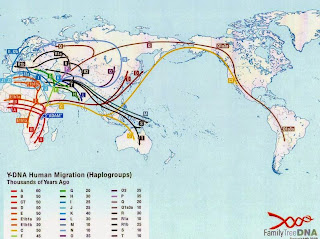The pariahs of ancient Britain are now the beloved ancestors of modern descendants. Who would have predicted that during the invasions?
Personally I wouldn't have my DNA tested to find so called "Viking DNA". When someone's DNA is tested it isn't like tiny Vikings are found swimming in their DNA and pronounced Viking . Some haplogroups and subclades are more common among the Scandinavians. Vikings did invade Britain mixing their DNA with the earlier migrants. It would appear that many I1 Haplogroup members in Britain likely did have this Haplogroup passed down to them through Vikings invasions. Another source of I1 would have been from the Anglo/Saxons,Jutes and Frisians, and of course later migrations. Historical research, archeology, and DNA can shed light on these different origins.
The Viking DNA question came up in our Forgey DNA project. So far most of our Forgey/Forgy & Forgie testers have matched each other in our Y DNA project; and they are grouped together in the I2b haplogroup. Some R1b's surfaced and were found to be the result of line breaks due to the surname coming down a female line, instead of a male line. We have two testers, however, who don't match our other Forgey group members and don't match each other. They were expected to match each other, at the very least, because they are 5th cousins on paper. Looking at the paper trail for these two people we can't find the explanation for the break? According to a biography for one of their Forgy ancestors, Robert Forgy, was an Irish immigrant to America in the 18th Century. This corresponds with the rest of our other Forgey/Forgys, who arrived in America around the same time and were Scots-Irish. My theory is the name Forgey/Forgy & Forgie is a variant of Ferguson as stated in a book written about Irish surnames, which was based on a government report on Irish surnames. Not all Fergusons are related, and throughout time there have been breaks in surname lines which could explain these two 5th cousins not matching the rest of us. So my questions are when did the break occur between these cousins, and does one of their lines go back to Ireland and the surname Ferguson? Did both of their lines have a break after this Robert Forgy arrived in America?
One of the lines is our beloved "Viking haplo" I1 M253, or the haplogroup often attributed to the Vikings by testing companies. Looking at their match list about half a dozen of this I1 Forgy's 42 matches, at 37 markers, are Scandinavian. This as opposed to our I2b haplogroup which is predominantly made up of Scottish and Scots-Irish matches with a couple Spanish matches, but no Scandinavians. I've been analyzing this persons I1 results over and over trying to figure out if this person's ancestors could indeed have been Scots-Irish, as stated in the 19th Century biography? Another possible explanation is a break occurred in this Forgy family in the Great Plains area where the family later migrated to in the 19th Century from Pennsylvania? I've been wavering back and forth on that question.
The Scandinavians are high up on this persons match list. In fact their closest match is a Norwegian man, who apparently still lives in Norway. This had led me to believe the break occurred on the Great Plains in the US. The myOrigins ethnicity prediction for this Forgy doesn't show any Scandinavian admixture. It shows 100% British Isles. The ethnicity predictions at Family Tree DNA are notoriously off, so the lack of Scandinavian admix may not mean much. Looking at this persons Family Finder results we find one match with a couple Scandinavian lines. This match shares a 32 cM segment. This person also has British Isles ancestry so it's hard to say where the 32 cM segment comes from?
Here is an example of this Forgy's top matches from haplogroup I M253:
This Forgy's 42 matches mostly consist of Scandinavian and British matches and one Slovakian match. This is a very unusual match makeup as compared to all of the other Scottish and Scots-Irish match results that have been shared with me.
Here is the information from the Ancestral Origins list Family Tree DNA provides (comparing at 37 markers):
This can be contrasted with the results of another I1 Haplogroup member who has confirmed Scottish ancestry going back to the Middle Ages (comparison at 67 markers) No Scandinavians:
Since there are UK matches I can't dismiss the possibility that this Forgy's ancestors were Scots-Irish, as stated in Robert Forgy's biography. This could be his Haplogroup? The other descendant of Robert Forgy has numerous matches, because he is in the R1b Haplogroup. One of his surname matches suggests the possibility of a break in his line, and his surname coming down through a female line. So far the R1b Forgy hasn't taken the autosomal test, which could establish whether there was a break in both of these lines or just one? If they match on the autosomal it would suggest that the R1b tester's surname came down a female line.
I believe we may be able to compare 2 fourth cousins from these separate branches of Robert Forgy's descendant lines? Hopefully that will answer some of our questions?
I am not sure if we are looking at ancient Scandinavian roots on the I1 Forgy's match list or something much closer? Do the results suggest Viking origins? I'm not expert enough to answer that question. Hopefully these mysteries can be answered at some point.









